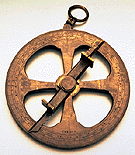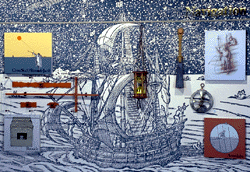Canada Hall

 North Atlantic
Crossings
North Atlantic
Crossings
It was not until the fifteenth century that Europeans initiated more
frequent transatlantic crossings with the help of improved
navigational instruments, such as the
astrolabe. (Thus,
the first Norse settlement had virtually no impact on later European
exploration of North America.)
With a compass or lodestone, the sixteenth-century navigator could always locate magnetic North, even in the absence of any visible stars. Using Jacob's cross-staff or an astrolabe, he could determine latitude. With the aid of an hourglass, he could calculate time, longitude and the ship's speed. Finally, he could gauge the water's depth and explore the ocean floor with a sounding lead and line.
 European commerce and the importance
of marine resources encouraged seamen to venture farther and farther out
on the North Atlantic. The search for a sea route to the Spice Islands
and the Orient led Europeans such as
Cabotto,
Verrazzano,
Cartier,
Frobisher, Davis, Champlain and Hudson
to explore North America. The
exploitation of the Newfoundland fishing banks from the late fifteenth
century contributed to the continuing European presence in the northern
regions of the North America.
European commerce and the importance
of marine resources encouraged seamen to venture farther and farther out
on the North Atlantic. The search for a sea route to the Spice Islands
and the Orient led Europeans such as
Cabotto,
Verrazzano,
Cartier,
Frobisher, Davis, Champlain and Hudson
to explore North America. The
exploitation of the Newfoundland fishing banks from the late fifteenth
century contributed to the continuing European presence in the northern
regions of the North America.

